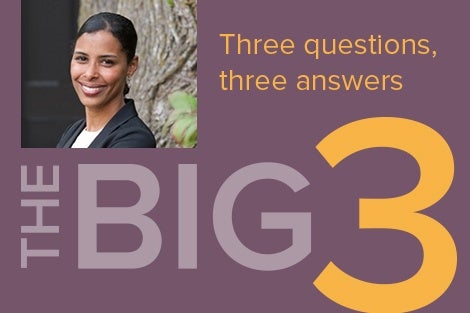April 7, 2017 —Sara Bleich, professor of public health policy at Harvard T.H. Chan School of Public Health, recently co-authored a Perspective in the New England Journal of Medicine that offered ideas for modifying the Supplemental Nutrition Assistance Program (SNAP) to promote population health.
Why do you think SNAP needs to be updated?
SNAP is one of the largest safety net programs in the United States, and the largest nutrition program. It currently helps 45 million low-income Americans—nearly half of them children—pay for food each month. But while the program’s current benefits reduce hunger, they don’t go far enough to help most families to purchase healthy food.
What are some ways SNAP could be modified to promote healthier diets?
Policies introduced in the two most recent Farm Bills—the mechanism through which Congress authorizes SNAP—were a good start. The 2008 bill included a pilot program to test whether giving participants a 30-cent credit for fruits and vegetables for every SNAP dollar they spent increased purchases of these foods. It did, by 26%. The 2014 bill included a requirement that SNAP retailers make a wider variety of healthy foods available to participants.
But these and other initiatives within SNAP that encourage healthier food choices currently reach less than 5% of recipients. More funding is needed to expand these programs—or to fund new programs that encourage the purchase of fruits and vegetables.
In addition to promoting purchases of healthy food, my co-authors Eric Rimm of Harvard Chan School, and Kelly Brownell of Duke University, and I think SNAP should discourage the purchase of unhealthy food, particularly sugary beverages. Currently, SNAP recipients spend a higher proportion of their grocery bill on soda than any other item (about 5 cents out of every dollar). There has not been an empirical test yet to see what would happen if SNAP recipients were restricted from using their benefits to buy sugary beverages. To date, all states that have wanted to introduce restrictions on SNAP purchases have been denied by the U.S. Department of Agriculture (USDA), which administers the program.
Another option that could work, and which might receive broader political support, would be to give SNAP recipients a choice between the current version of the program and a modified version in which benefits would be a little higher but couldn’t be used to purchase sugary beverages.
The next Farm Bill reauthorization is in 2018. In addition, President Trump’s budget proposal for the next fiscal year includes a 21% cut to the USDA. What are your concerns about the future of the program?
The area of USDA that runs SNAP takes up about two-thirds of the department’s budget. If the overall USDA budget gets cut, that’s probably going to have consequences for SNAP.
SNAP is designed to be responsive to the economy, and during the recession it was able to accommodate an enrollment spike. By comparison, the cash assistance program Temporary Assistance for Needy Families (TANF) was less responsive. This is because it is administered as a block grant, which is a fixed payment from the federal government to the states. Because block grant amounts remain the same year after year, their purchasing power diminishes over time. In addition, because block grants give flexibility to states, some may choose to limit benefits.
If funding for SNAP gets converted into a block grant, as some have proposed, the value of the program will go down considerably over time.
SNAP is a program where investment seems to have important broader societal benefits. There is a big body of research to show that SNAP is effective at reducing food insecurity, and it has been helpful for lifting people out of poverty. It’s also been shown to have an important impact on children’s health and education outcomes.
At the very least, SNAP should not be reduced. But we hope that policymakers will continue to adopt public health approaches that will make the program stronger and more responsive to the needs of low-income Americans.
